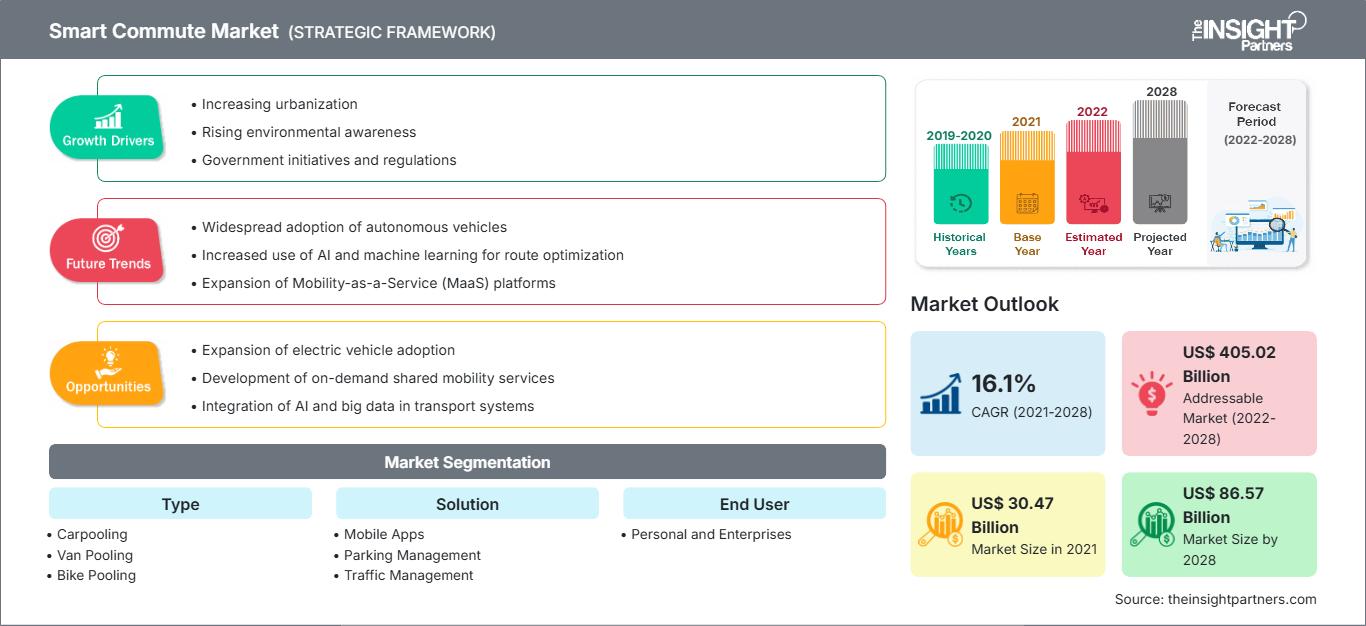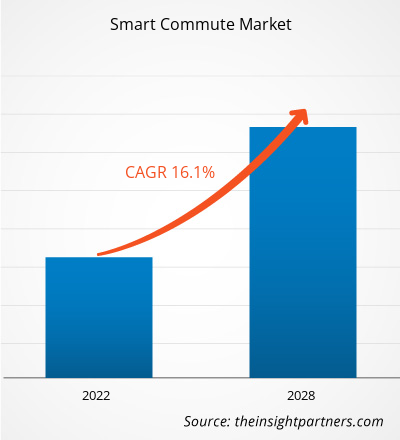스마트 통근 시장은 2021년 304억 6,949만 달러에서 2028년 865억 6,873만 달러로 성장할 것으로 예상되며, 2021년부터 2028년까지 연평균 성장률 16.1%로 성장할 것으로 예상됩니다.
스마트 통근은 카풀, 밴풀, 자전거, 자전거 또는 지하철을 이용한 정기적인 이동으로 정의됩니다. 대중교통 회사, 정부 및 기타 이해관계자들은 스마트 이동을 고려하고 이를 대중과 공유하여 대도시 지역의 더욱 효율적인 교통 체계를 구축하는 포괄적인 전략을 개발해 왔습니다. 스마트 통근은 교통 체증을 줄이고 온실가스 배출을 줄임으로써 환경에 긍정적인 영향을 미칩니다.
카풀, 자전거 공유, 밴풀 및 기타 친환경 통근 옵션은 스마트 통근 서비스를 통해 제공됩니다. 스마트 통근 서비스는 직장인에게 교통 체증과 교통비 지출을 줄이는 더욱 효과적인 통근 경로를 선택할 수 있는 교통 옵션을 제공합니다. 스마트 통근 시장 성장을 촉진하는 요인 중 하나는 도시 거주자 증가로 인한 세대 간 요금 상승입니다. 공유 교통 서비스는 전 세계적으로 수용되고 있으며, 정부와 환경 단체에서 탄소 배출 감소에 도움이 된다는 이유로 장려하고 있습니다. 공유 교통 서비스는 개인 차량 감소를 가능하게 하여 향후 스마트 통근 시장 성장을 촉진할 것으로 예상됩니다. 북미 지역에서는 교통 체증을 완화하고 환경 피해를 예방하기 위해 직장인들의 카풀 서비스 선호도가 증가하면서 스마트 통근에 대한 수요가 급증했습니다. 또한, 관광 산업의 성장, 기술 발전, 그리고 정부의 우호적인 정책 또한 북미 스마트 통근 시장 성장을 견인하는 요인입니다. 유럽에서는 모빌리티 서비스(MaaS) 트렌드의 확산과 승차 공유 서비스 사용자 기반 증가가 시장 참여자들에게 수익성 있는 기회를 제공할 것으로 예상됩니다. 유럽에서는 지구 온난화, 도로 혼잡, 그리고 해외 에너지 의존도에 대한 우려가 커지면서 스마트 통근자의 인기가 높아지고 있습니다. 2012년에 시행된 1인 탑승 자동차에 통행료를 부과하는 관행으로 인해 유럽 소비자의 스마트 통근 이용이 엄청나게 증가했습니다.
요구 사항에 맞게 이 보고서를 사용자 정의하십시오.
이 보고서의 일부, 국가 수준 분석, Excel 데이터 팩을 포함하여 모든 보고서에 대한 사용자 정의를 무료로 받을 수 있을 뿐만 아니라 스타트업 및 대학을 위한 훌륭한 제안 및 할인을 이용할 수 있습니다
스마트 통근 시장: 전략적 통찰력

-
이 보고서의 주요 주요 시장 동향을 확인하세요.이 무료 샘플에는 시장 동향부터 추정 및 예측에 이르기까지 데이터 분석이 포함됩니다.
COVID-19 팬데믹이 스마트 통근 시장에 미치는 영향
COVID-19 팬데믹은 교통 부문에 상당한 영향을 미쳤습니다. COVID-19로 인해 2020년 전 세계적으로 카풀 및 밴풀 서비스 수요가 감소했습니다. 전 세계 스마트 통근 시장은 2019년 대비 2020년 매출이 크게 감소했는데, 이는 봉쇄 조치와 규제 해제 후에도 고객들이 승차 공유 서비스를 이용하기를 꺼리는 데 기인한 부분적인 원인입니다. 승차 공유 기업들은 안전 및 위생 측면에서 운전자와 승객의 신뢰를 유지하기 위해 끊임없이 노력하고 있습니다.
시장 분석– 스마트 통근 시장
서비스형 모빌리티(MaaS)의 증가 추세
차량 구매가 어려운 사람들은 모빌리티 서비스를 통해 원활한 이동을 경험할 수 있습니다. 미국 교통통계국(Bureau of Transportation Statistics)에 따르면, 연간 15,000km를 주행한다고 가정할 때 차량 소유 및 운영 비용은 평균 약 8,858달러입니다. MaaS는 카풀이나 승차 공유와 같은 교통 서비스 이용을 극대화하여 사용자의 이러한 비용을 절감합니다. 또한 도시의 교통 체증과 전반적인 자동차 배출량을 줄입니다. 결과적으로 디지털 기반 카풀과 승차 공유는 교통 수요를 효율적으로 관리하고 개인 자동차 소유에 대한 편리하고 환경 친화적인 대안을 제공합니다. 더욱이 통계에 따르면 현재 전 세계 인구의 55%가 도시에 거주하고 있으며, 2050년까지는 인구의 약 68%가 도시에 거주할 것으로 예상됩니다. 급속한 도시화는 이미 교통 체증으로 이어지고 있습니다. 서비스형 모빌리티(MaaS) 개념은 기존 대중교통 및 민간 교통 인프라를 더욱 효과적으로 활용하여 교통 체증을 줄이는 데 더 나은 선택이 될 수 있습니다. 스마트 시티의 교통을 더 빠르고 저렴하며 편리하게 처리할 수 있는 효과적인 솔루션에 대한 수요가 급증함에 따라 2028년까지 MaaS 시장 성장이 가속화될 것으로 예상됩니다. 따라서 서비스형 모빌리티(MaaS)의 증가 추세는 글로벌 스마트 통근 시장의 성장을 촉진할 것으로 예상됩니다.
유형별 스마트 통근 시장 분석
스마트 통근 시장은 유형별로 카풀, 밴풀, 자전거 풀, 지하철 등으로 구분됩니다. 카풀 부문은 글로벌 스마트 통근 시장에서 상당한 점유율을 차지할 것으로 예상되며, 가장 높은 연평균 성장률(CAGR)을 기록할 것으로 예상됩니다. 스마트 통근은 카풀, 밴풀, 자전거, 또는 지하철을 이용하여 한 지점에서 다른 지점으로 정기적으로 이동하는 것을 의미합니다.
솔루션 기반 스마트 통근 시장 분석
스마트 통근 시장은 솔루션 기반으로 모바일 앱, 주차 관리, 교통 관리 등으로 세분화됩니다. 모바일 앱 부문은 글로벌 스마트 통근 시장에서 상당한 점유율을 차지할 것으로 예상되며, 가장 높은 CAGR(연평균 성장률)로 성장할 것으로 예상됩니다. 이동 시간, 비용 및 차량 배출량을 줄이기 위해 자동차 이동 수단에서 모바일 애플리케이션 사용이 증가하고 있습니다.
최종 사용자 기반 스마트 통근 시장 분석
최종 사용자를 기준으로 스마트 통근 시장은 개인 및 기업으로 구분됩니다. 기업 부문은 글로벌 스마트 통근 시장에서 상당한 점유율을 차지할 것으로 예상되며, 더 높은 CAGR(연평균 성장률)로 성장할 것으로 예상됩니다.
스마트 통근 시장The Insight Partners의 분석가들은 예측 기간 동안 스마트 통근 시장에 영향을 미치는 지역별 동향과 요인을 면밀히 분석했습니다. 이 섹션에서는 북미, 유럽, 아시아 태평양, 중동 및 아프리카, 그리고 중남미 지역의 스마트 통근 시장 세분화 및 지역별 분포도 살펴봅니다.
스마트 통근 시장 보고서 범위
| 보고서 속성 | 세부 |
|---|---|
| 시장 규모 2021 | US$ 30.47 Billion |
| 시장규모별 2028 | US$ 86.57 Billion |
| 글로벌 CAGR (2021 - 2028) | 16.1% |
| 이전 데이터 | 2019-2020 |
| 예측 기간 | 2022-2028 |
| 다루는 세그먼트 |
By 유형
|
| 포함된 지역 및 국가 |
북미
|
| 시장 선도 기업 및 주요 회사 프로필 |
|
스마트 통근 시장 참여자 밀도: 비즈니스 역학에 미치는 영향 이해
스마트 통근 시장은 소비자 선호도 변화, 기술 발전, 그리고 제품 이점에 대한 인식 제고 등의 요인으로 인한 최종 사용자 수요 증가에 힘입어 빠르게 성장하고 있습니다. 수요가 증가함에 따라 기업들은 제품 및 서비스를 확장하고, 소비자 니즈를 충족하기 위한 혁신을 추진하며, 새로운 트렌드를 적극 활용하고 있으며, 이는 시장 성장을 더욱 가속화하고 있습니다.

- 을 얻으세요 스마트 통근 시장 주요 주요 플레이어 개요
스마트 통근 시장에서 활동하는 업체들은 주로 고급스럽고 효율적인 제품 개발에 집중하고 있습니다.
- 2022년 1월, 멀티모달 모빌리티 기업인 Tummoc은 델리와 뭄바이를 포함한 2022년까지 다른 10개 도시로 사업을 확장할 계획입니다.
- 2021년 4월, 도시 기반 모빌리티 기업이 버스, 지하철, Uber, Yulu 및 기타 마지막 마일 선택을 결합하여 경로와 가격을 처음으로 통합하는 앱 플랫폼을 구축했습니다.
회사 소개
:- BlaBlaCar
- CommuteSmart
- Enterprise Holdings Inc
- ePoolers Technologies Pvt. Ltd
- Golden Concord Holdings Limited
- Oakland Smart Commute
- Quick Ride
- Transhelp Technologies Pvt Ltd
- Uber Technologies Inc.
- Smart Commute
- 과거 분석(2년), 기준 연도, CAGR을 포함한 예측(7년)
- PEST 및 SWOT 분석
- 시장 규모 가치/거래량 - 글로벌, 지역, 국가
- 산업 및 경쟁 환경
- Excel 데이터세트
최근 보고서
사용 후기
구매 이유
- 정보에 기반한 의사 결정
- 시장 역학 이해
- 경쟁 분석
- 고객 인사이트
- 시장 예측
- 위험 완화
- 전략 기획
- 투자 타당성 분석
- 신흥 시장 파악
- 마케팅 전략 강화
- 운영 효율성 향상
- 규제 동향에 발맞춰 대응






















 무료 샘플 받기 - 스마트 통근 시장
무료 샘플 받기 - 스마트 통근 시장